Volkswagen Golf R Mk 8.5 2025 review: Australian first drive
This will be the final petrol-powered interaction of the Golf R, but will this brutally effective hot hatch be remembered as a high point in the model’s history?
“Damn shame,” I mutter to myself, blasting out of a tight, sodden corner at the chunky wheel of the new Mk 8.5 Volkswagen Golf R.
My blues are due to this likely being the final combustion version of Volkswagen’s most halo’d of hatchbacks, it bookending a range that kicked off in 2002 with the VR6-equipped Golf Mk4 R32.
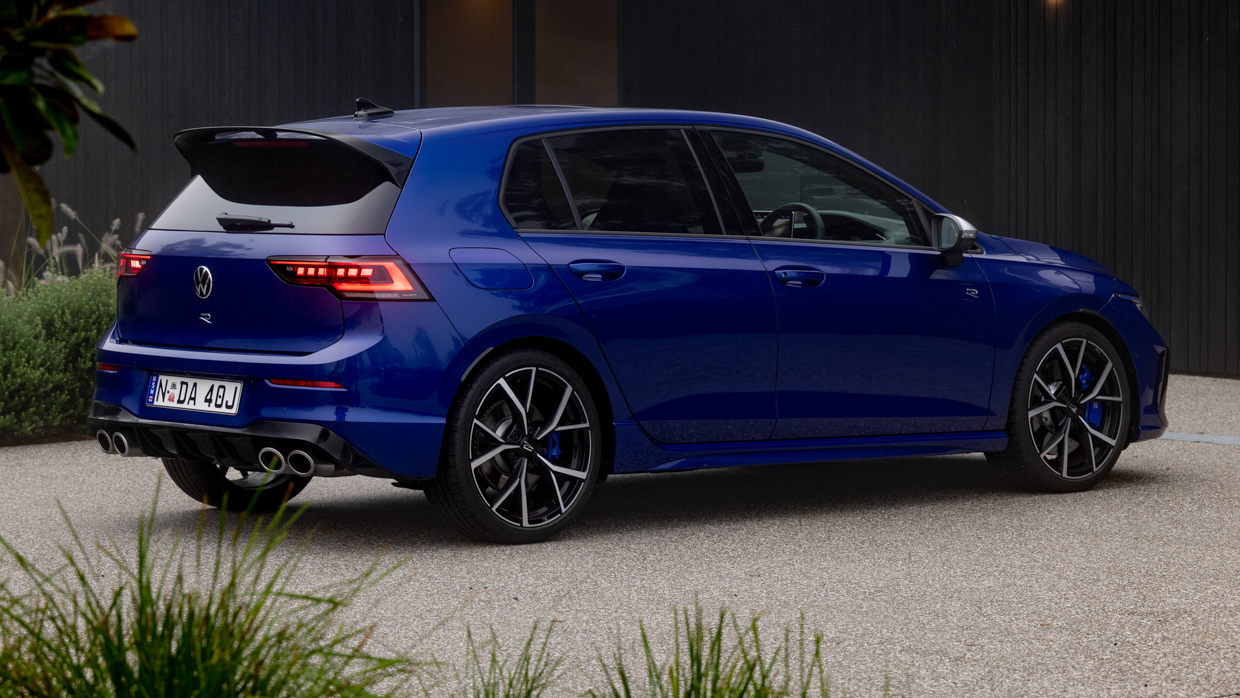
The next generation Golf R? Like the GTI hatchback, that’s going to be electric only.
I remember road testing the R32 when it was new over two decades ago, and the thought of no Golf R with a fizzing, petrol-sucking engine is hard to swallow. Equally, where the hell have those 23 years gone?
The march of progress is relentless, as witnessed with this mildly aesthetically facelifted Golf R with the inevitable jump in power, performance and tech.
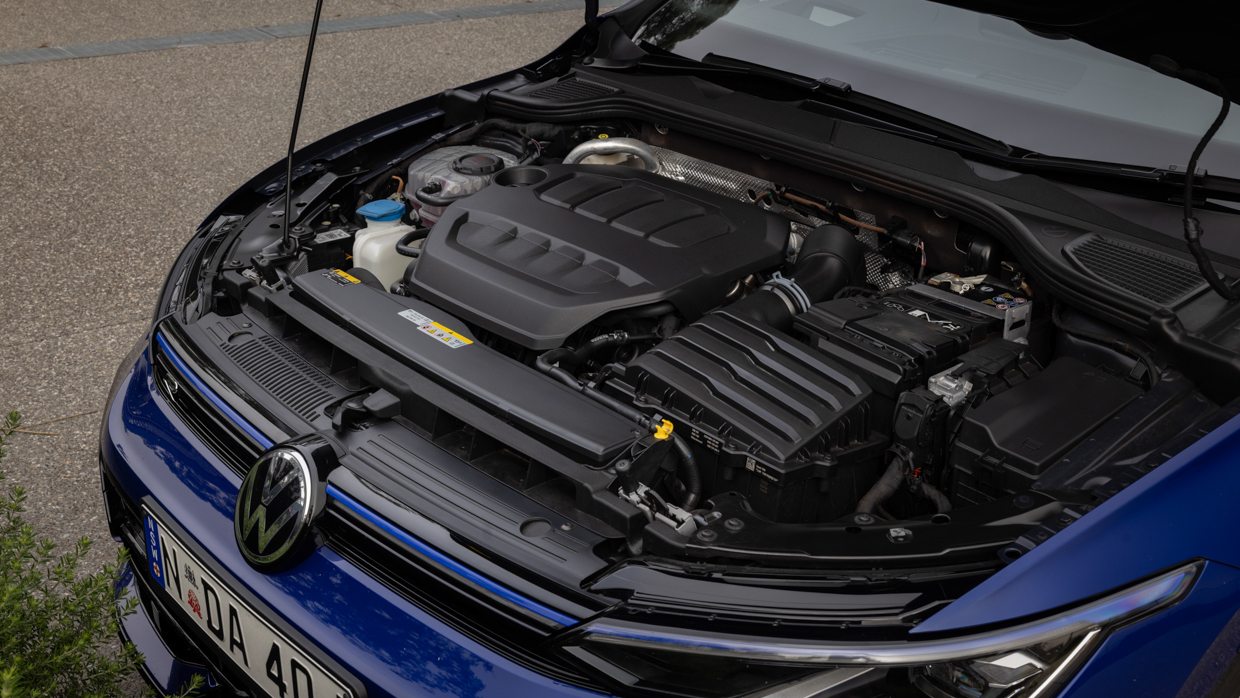
Price of entry is now $70,990, which is a modest $500 over the old model. It buys the fresher face already seen on garden variety Golf 8.5s; a much-needed 12.9-inch infotainment screen to replace the dated 10-incher; a surround view camera, and it’ll even park itself if you’re especially lazy or talentless.
Performance hunters will be more appreciative of the solid 10kW and 20Nm jumps for the EA888 2.0L four-cylinder, the turbo petrol now punching out a solid 245kW and 420Nm, helping drop its 0-100km/h time from 4.8 seconds to 4.6 seconds.
“The athlete in a tailor-made suit,” is how VW sees its all-wheel-drive Golf R, and is backed by a solid amount of included kit, not least prestige-y stuff like adaptive damping, heated and ventilated Nappa leather seats and Harman Kardon audio.
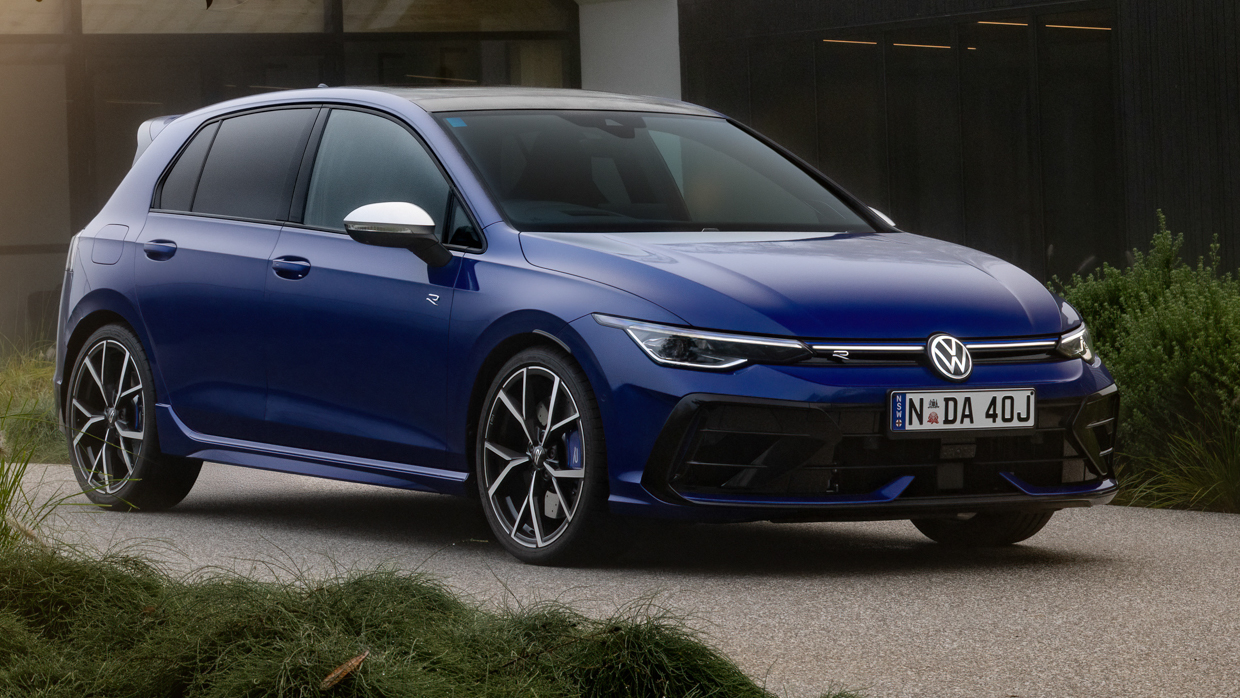
It may be damn pricey for a Golf – around twice that of the entry-level 1.4L Life – but the value proposition isn’t bad once key areas are all considered, and when pitching it against the competition.
It trumps the similar-priced Toyota GR Corolla GTS and front-drive Honda Civic Type R for power, torque and acceleration, but these Japanese offerings may appeal more to the purist with their manual transmissions. The Golf R, of course, is seven-speed DSG auto only.
Compare the Golf R to all-paw German prestige hatchbacks, namely the BMW M135 xDrive and Mercedes-AMG A35, and the Volksy again wins on power, torque and 0-100km/h, while costing up to $18,000 less.
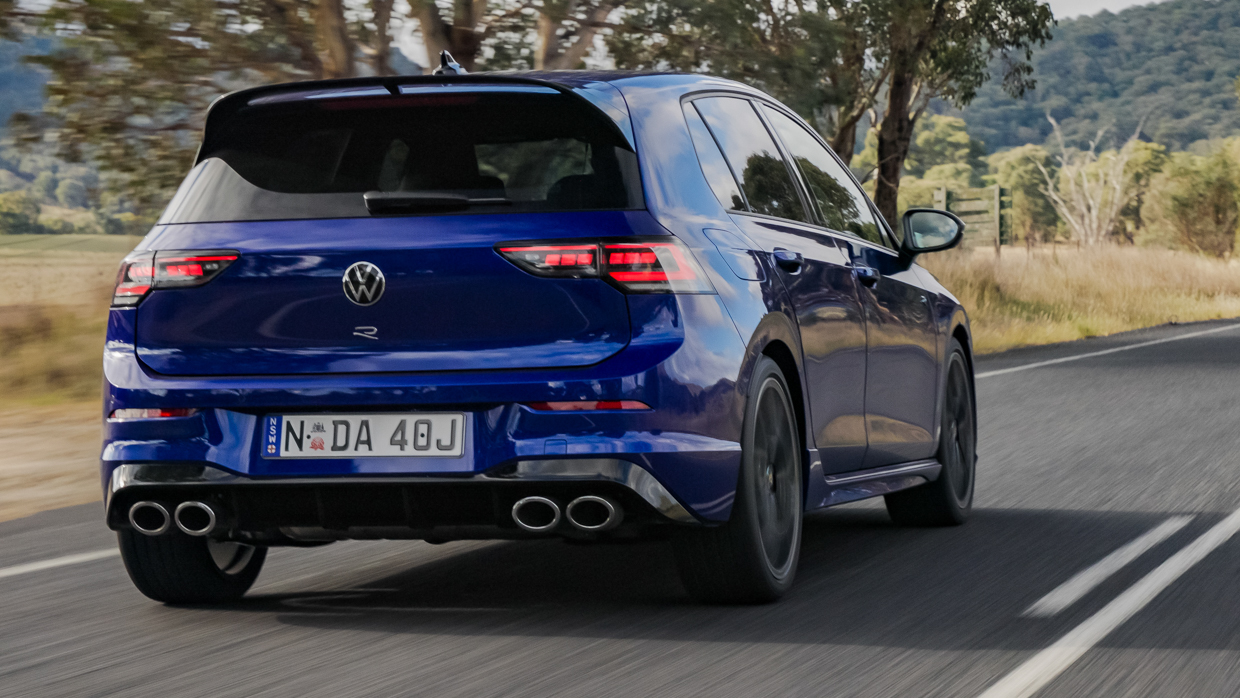
But numbers mean only so much. Recent Golf Rs have been criticised for being almost too good; in that the driver need only point and shoot.
It’s unquestionably quick, but handling and grip make it near unstickable, the electronics effectively mop up loss of traction, and there’s some rawness and driver involvement missing when compared to earlier Golf Rs.
On first drive across NSW’s Central Tablelands, this Mk8.5 R remains video game-like easy to drive fast and accurately, that’s despite pothole puddles, smashed up road surfaces and streams running across the test roads.
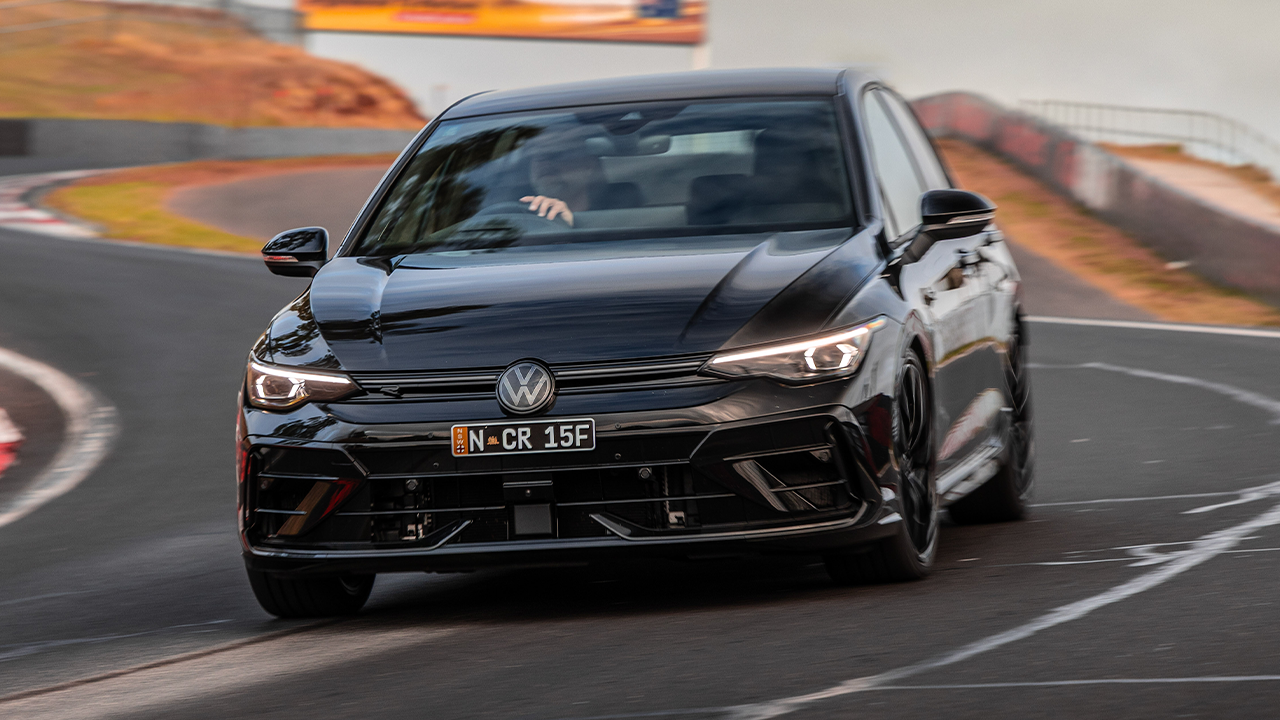
If I benchmark the funnest of hot hatches – Toyota GR Yaris, Civic Type R, Hyundai i30N and Ford Fiesta/Focus ST – the Golf R is a notch down for outright driving joy. Instead, it’s the grown up in the room. And good grief I’d take the Volkswagen over any of the above for everyday life, or a journey over 100km.
Our grismal conditions test helped the Golf R shine. Despite the greasy, choppy surface, the way it puts power down and pulls with brute force is mind-bending.
There’s a torque locomotive going through each 235/35R19 Bridgestone Potenza S005, and after about 4000rpm the fireworks are in overdrive, and you finally get a bit of serious exhaust bark.

Development driver Benny Leuchter – a Nürburgring 24 Hour class winner with Volkswagen – has played a key hand in this latest Golf R, pushing for “a bit more feel for racing characteristics,” he said.
There’s a “turbocharger preload” which holds the turbo’s speed when off-throttle, arming it for quicker response when asked to spool up again. The throttle valve also stays partially open in overrun mode, so when you’re back on the loud pedal, turbo lag is near eradicated, shoving torque to wherever the brains decide.
This brings us to the R-Performance torque vectoring rear differential, which has been heavily revised over the old Mk8’s version. Half of the available torque goes to the front axle, but the remaining 50 per cent can be moved completely variably between the rear wheels.
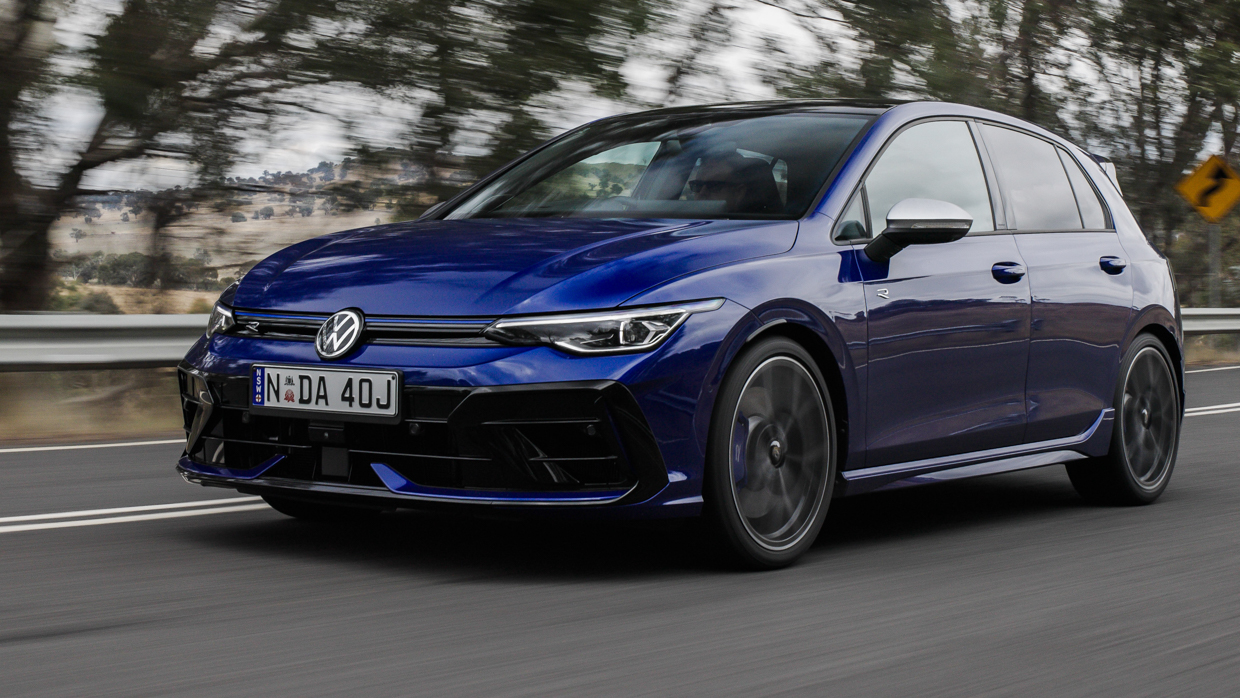
That means, if needed, all rear axle torque can go to a single outside wheel.
The car and whatever drive mode you’re in (there are six to choose from, including a Drift mode) have final say on torque-split decisions, but it means oversteer is readily available, but overwhelmingly you’ve a hatch that’s even more like it’s on rails, unless you’re madly pushing at a race track.
The boosted engine, mega-quick gear upshifts and all-wheel-drive system are endlessly impressive, but perhaps the most ridiculous aspect is how effective the R’s adaptive damping is.
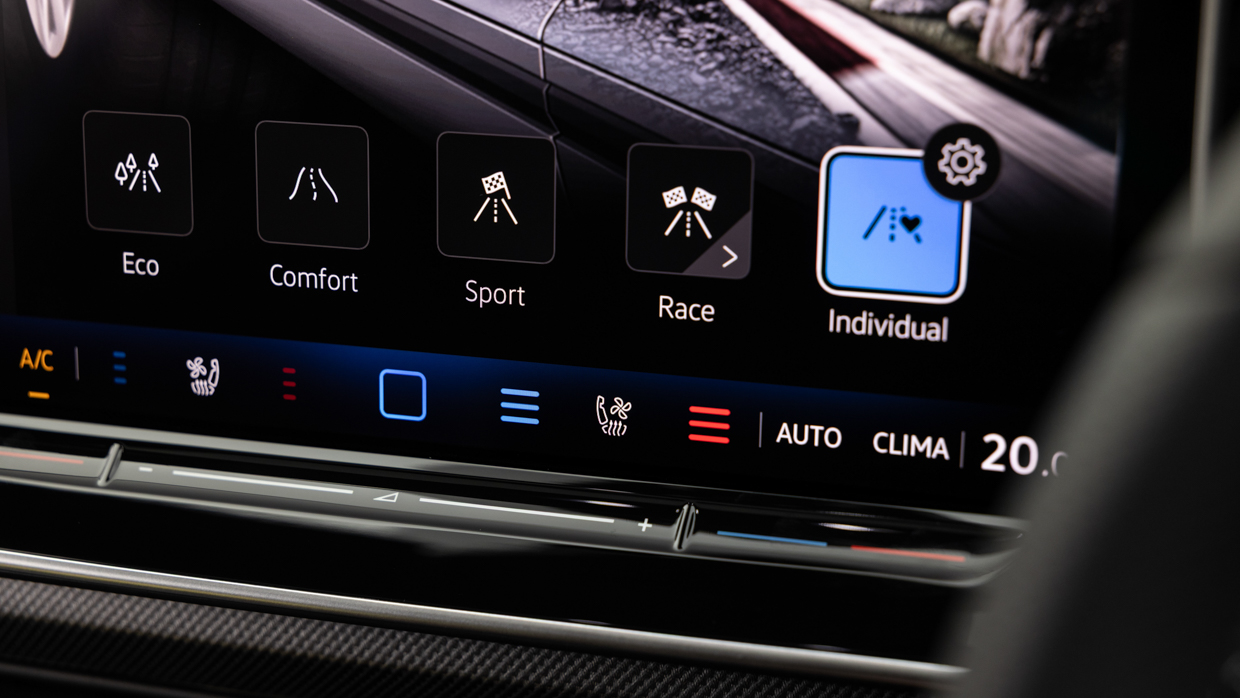
It features 15 different settings, ranging from utmost Comfort to spine-smashing Race, with everything in between.
In most compliant mode, ride quality feels as easy-going and comfy as a rock stock basic Golf – it mops up the road hits and sets out its stall as an everyday car far more convincingly than the likes of an Hyundai i30N or Honda Civic Type R.
Shift through modes and the likes of Sport and Sport+ add more attack to engine response, gear shifts and steering, while gradually firming up the suspension.

Best of all worlds is a “Special” Nürburgring mode. As Germany’s Green Hell – where the R spent many hours in development – demands utmost performance but with soft suspension due to the track’s uneven surface, this setting also proves ideal for Australia’s less-than-perfect rural roads.
It helps make the R feel incredibly safe, comfortable and outright simple to drive fast on crummy country twisties. There’s also a more welcome baritone coming from the exhaust.
An aspect Nürburgring-ace Leuchter and engineers at “R” are incredible proud about is the dual clutch auto’s shift pattern.
Like a Porsche’s PDK, it takes aspects such as braking force, steering lock and drive mode into consideration, and determines what gear’s best for the upcoming corner.
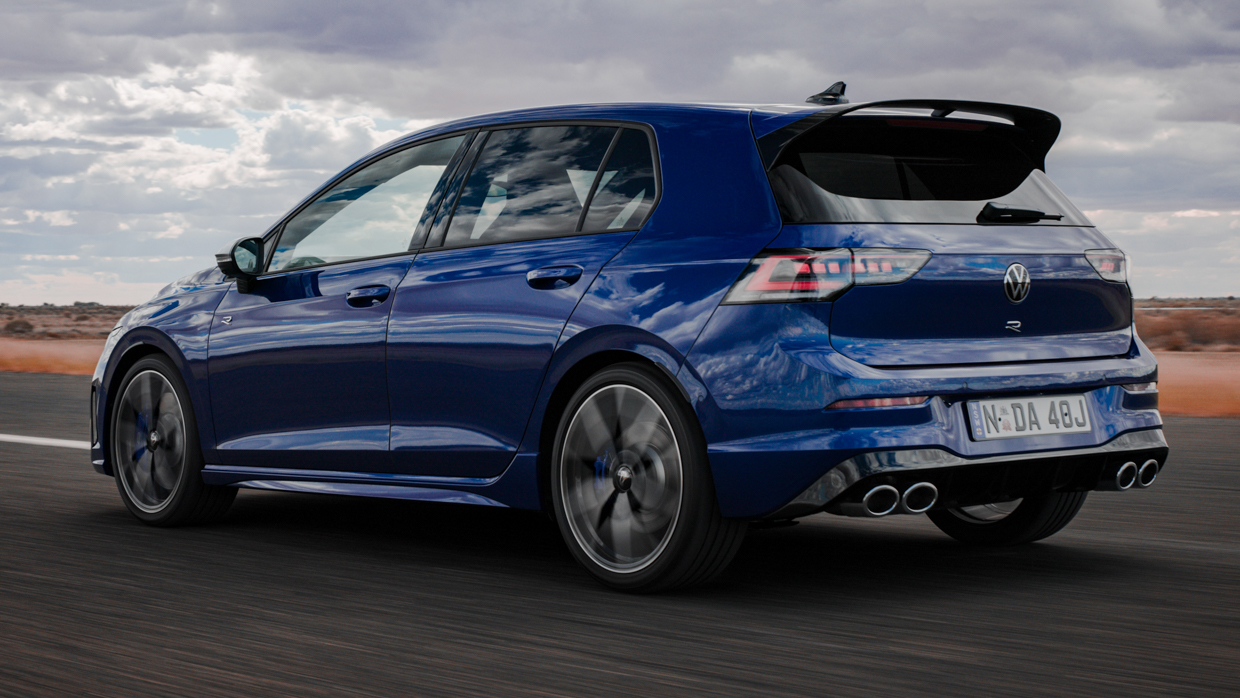
It downshifts appropriately, and proved excellent on our test, almost telepathically knowing the cog you want and when. It wasn’t perfect all the time, so I still preferred moving into DIY mode where complete control’s offered through steering wheel paddles.
Leuchter also explained the gearbox wouldn’t auto upshift in a corner, “because it unsettles the car on a hot lap,” then emphasising even the Porsche version doesn’t offer this.
Lovely stuff for the track enthusiast, as is the R’s GPS lap timer; accelerometer to log acceleration across different speeds; launch control, and that Drift mode… if allowed.

Sadly I wasn’t able to test the latter on the car’s launch event, but previous professional hooliganism with the Mk8 has confirmed that this is indeed a good time.
Over half a dozen track laps the mega Golf proved it could shame pricier exotica, such is its speed and poise, although we weren’t out long enough to discover how the brakes would hold up. Over those laps, there was no noticeable fade and plenty of bite. If you hit the track lot, it pays to do brake upgrades anyway.
The Golf R’s neatest trick is, perhaps more than any other car, being able to do hot track laps then drive home in utmost comfort. It masterfully handles this challenge, the importance of the trick suspension at the fore.
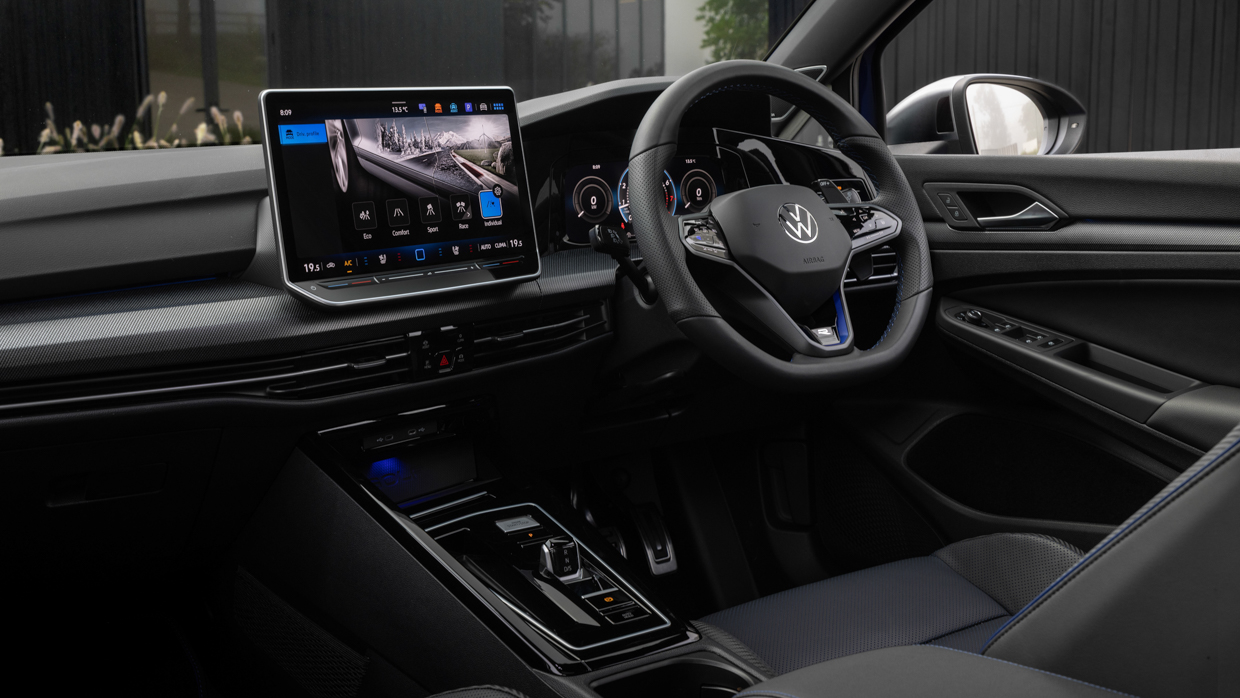

The cabin’s a quite sumptuous place to be. Nappa leather seats not only cool and heat, but the driver’s is power and memory too. Plastics are soft touch up front, there’s carpet for door bins and the new infotainment is a marked improvement with decent 360-degree cameras.
Apple CarPlay and Android Auto are wireless (there are also four USB-C ports), there’s a smart clip to hold a phone on a wireless charge pad, while there’s 30 ambient lights, tri-zone climate control and a head-up display.
If I’m grumbling, the piano black centre console is a magnet for fingerprints, climate is through a screen (although with smart shortcut buttons), and unlike other Golf 8.5s, haptic steering wheel buttons remain.
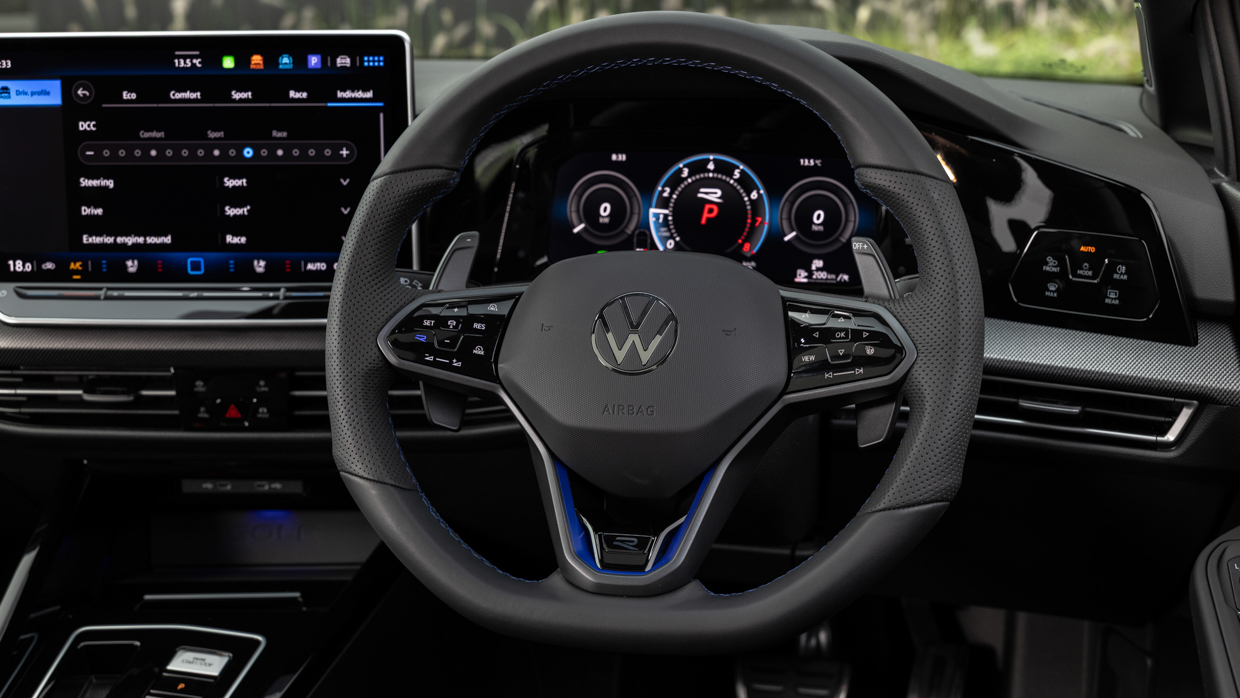
You do kind of get used to them, but I kept accidently nudging the steering wheel heater button when enthusiastically driving.
It’s a dark but classy and roomy cabin, which you can brighten up a smidge with the optional $1900 panoramic sunroof.
The back seats are a good size for a couple of adults, the leather-appointed chairs proving comfy, leg and head room fine, although the plastic door trim’s now a bit more budget.

The boot’s also fine for the small car class: 341L on offer, but only a repair kit under the floor. Fold the rear seats and there’s 1197L, but the extra space a wagon offers is once again not offered to Australians. The 8.5 Golf R wagon’s on sale overseas, but it isn’t for us.
There are 300 Golf R Black Editions being offered locally, with black styling and more available at $72,490. The $1500 extra spend seems worth it alone for 19-inch black Warmenau alloy wheels, which are 2kg lighter each than a normal Golf R’s 19-inch Estoril items. Decent unsprung weight saving there.
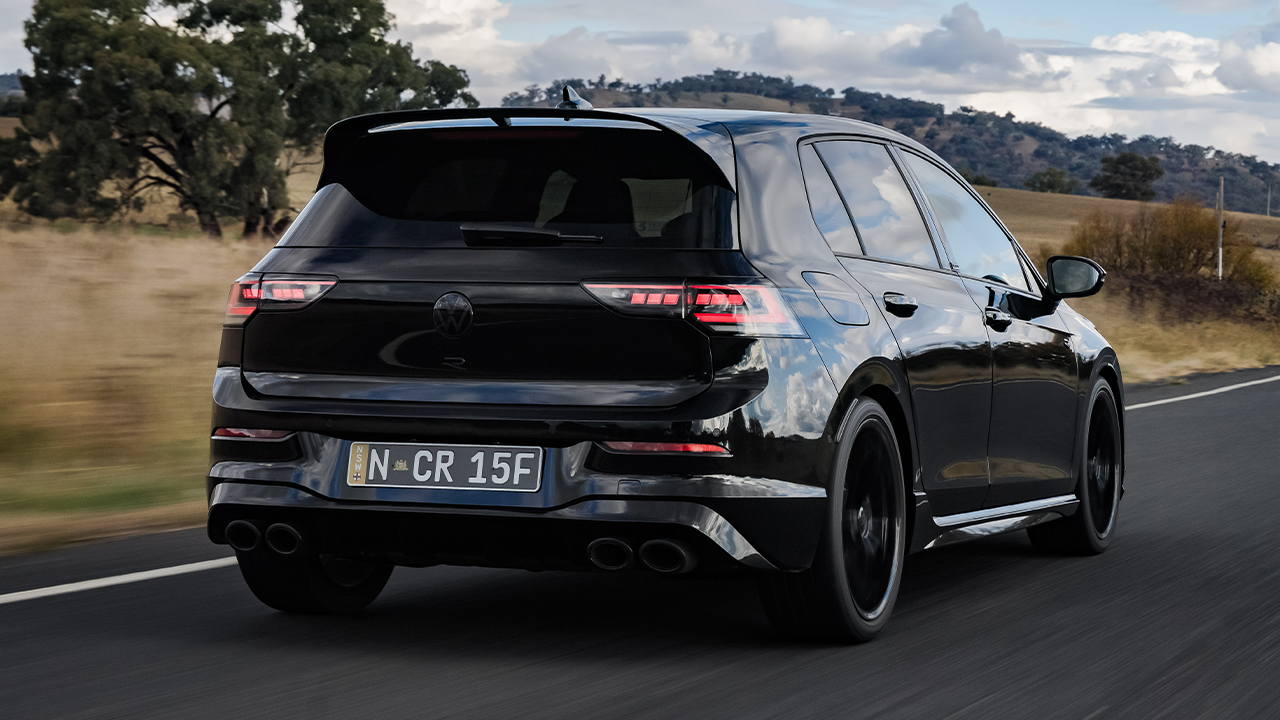
There’s black for the radiator grille, VW logos, matrix LED headlights, calipers, mirrors, exhaust tips and badges. It’s at its darkest and meanest on a black body, but the Black Edition accessories are also offered on other colours.
There’s an optional $6500 Warmenau Package, bringing the aforementioned lighter wheels, genuine carbon fibre décor inside, and an Akrapovic titanium exhaust, dropping weight by 7kg and offering a fruitier note.
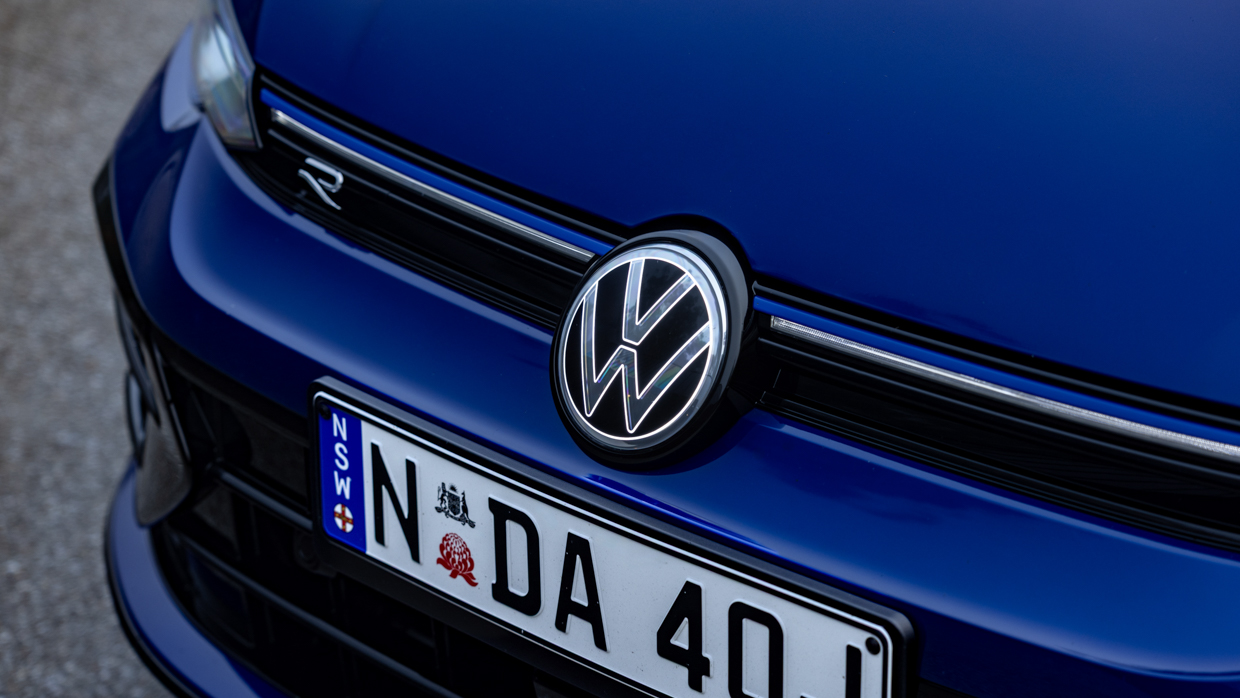
Volkswagen’s IQ.Drive driver assistance systems are included as expected – a full suite bar speed sign recognition – and kudos to the developers, there’s minimal disruption to the drive experience with over-nannying. The lane keep/centring proved a dash too keen to play a role, but it could easily be turned off.
Running costs? A positive is this new Golf R can run on 95 RON, rather than only the pricier 98 RON of before. Fuel use at 8.3L/100km is tolerable, but be aware if you’re out having proper fun as we did, we had 15L/100km showing.
Warranty’s five-years/unlimited kilometres, and positively, service visits are only every 12 months/15,000km, unlike some rival performance cars. Dealer trips aren’t cheap, however, with a service package costing $3640 for five years.

Few hot hatches do so many things so very well as this Mk 8.5 Golf R. It’s too expensive and complex for those who won’t fully exploit its performance and handling talents – a Golf GTI would suffice there – but for serious drivers it’s a deeply talented all-rounder.
It looks classy/fast without being overtly sporty or showy; has ample cabin luxe and features, and is a dead set daily driver with its endlessly impressive adaptive damping.
Then it’ll quickly move into back road hero or track weapon at the touch of a button. It doesn’t give the tingles of a raw, uncompromising mad hot hatch like a Civic Type R, but this VW impresses in a different way. For mature, expert competence with ballistic turbo performance, it’s unsurpassed in class.
If it’s the Golf R’s combustion swansong, it’s a great one. But as I said at the top, if it’s electric only by next decade, it’s a damn shame.
Hyundai Inster 2025 review: Australian first drive
4 months ago

There’s a price to pay for a polished drive and aftersales assurance, Hyundai bosses proclaim when explaining why the Inster is pricier than Chinese rivals.
Good points
- Surprisingly polished to drive
- Slick, refined electric drive
- Very light weight for an EV
- Real range beats claims
- Tiny outside, roomy inside
- Useful, easy cabin tech
Needs work
- More than $40K on-road
- Pricier than Chinese rivals
- Luxe spec limited to Cross
- Narrow track limits handling
- Runs out of puff at high speed
- Moderate road noise
Once mainstays of Australian roads, light and truly small cars dwindled in popularity for years – until electric power unexpectedly relit their fire, led in recent years by popular models like the MG4 (from $36,990 driveaway) and BYD Dolphin (from $29,990 plus on-road costs).
While Aussies can still buy petrol-fuelled littlies like the MG3, Suzuki Swift, Mazda 2 and Toyota Yaris, their prices have skyrocketed in recent years as safety tech costs have risen. At the same time, sales of such nameplates have fallen, with a rich share of buyers who can afford a small car in the thirty-grand range happy to shift to electric.
And picking up a ‘cheap’, small electric car in Australia has meant buying Chinese—until now. Hyundai, which cut its teeth on starter-pack vehicles like the Excel, Getz and Accent, enters the fray of Australia’s entry-level EVs this month with the new Inster SUV.

The Inster simply isn’t priced sharply enough to tear volume from strong-selling, PRC upstarts. Three variants commence from $39,000 before on-road costs (about $43K driveaway) – not devilishly expensive, but the Inster needs to shine brightly across the board to justify the price.
Hyundai executives are bullish that the Inster is, simply put, desirable enough. Its maker calls it segment-defying, blending kei car styling, intelligent cabin packaging, sorted driving dynamics and sophisticated technology.
In other words, Hyundai hopes that Australians see through the veneer of quality it feels is associated with some Chinese rivals: the Inster isn’t Dolphin or MG4-cheap (despite the latter being a pretty impressive car), but Hyundai says its car rides and steers properly, that its software is polished, and that warranty coverage and spare parts are dependable.
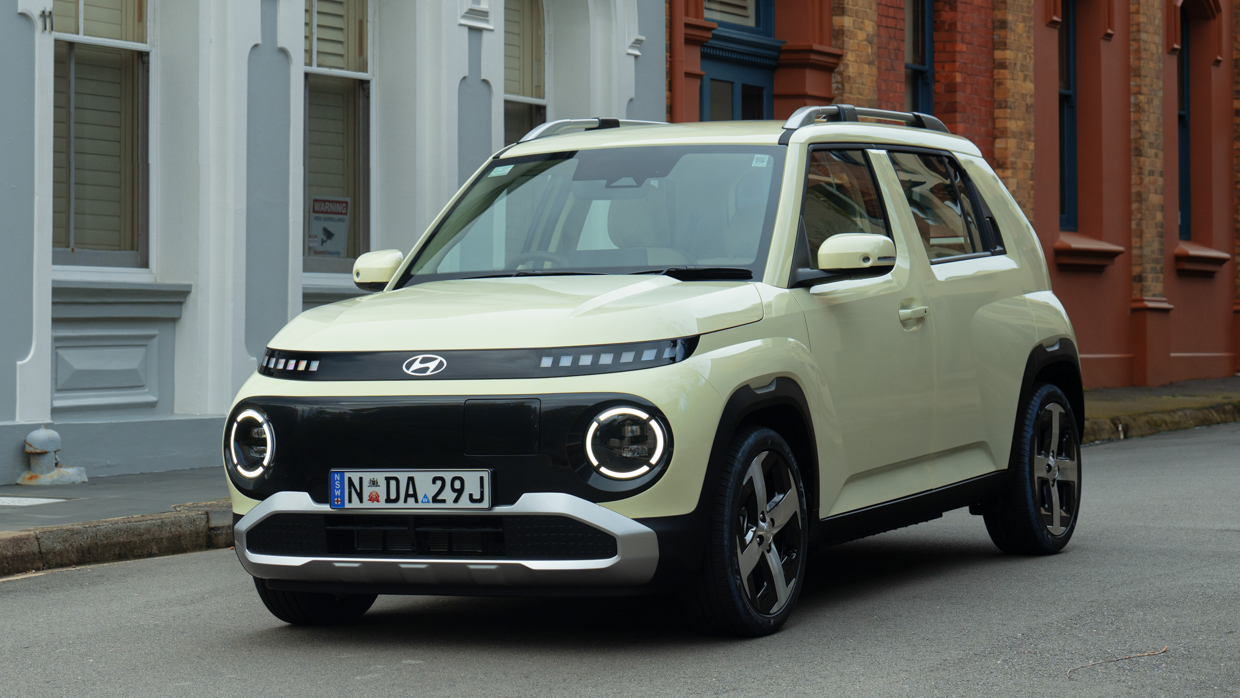
Certainly, our test revealed that the Inster feels much more polished and mature than you might expect from a first look at its cartoonish styling. Compared to some of the buggy vehicles from new brands we drive, it’s a bit of a breath of fresh air.
But is that sorted, straightforward experience worth a steep premium? Should you actually consider splashing up to $9000 more on the Hyundai than a BYD? That question was at the front of our mind for this test.
What are the Inster’s features and options for the price?
There’s a reason carmakers splash entry prices on billboards: it’s the factor that often gets buyers in the door (or to the website) for a first squizz. So, how much trouble is the Inster in, price-wise, as it gets out of the blocks? Here is a look at the starting prices of various electric rivals:
| Model | Price | Battery | Range WLTP | Power |
| BYD Dolphin Essential | $29,990 | 44.9kWh | 310km | 70kW |
| GWM Ora Standard Range | $35,990 d/a | 45.4kWh | 310km | 126kW |
| BYD Dolphin Premium | $36,990 | 60.5kWh | 427km | 150kW |
| Chery E5 Urban | $36,990 | 61.0kWh | 430km | 160kW |
| MG4 Excite 51 | $36,990 d/a | 50.8kWh | 350km | 125kW |
| Hyundai Inster | $39,000 | 39.0kWh | 327km | 71kW |
| BYD Atto 3 Essential | $39,990 | 49.9kWh | 345km | 150kW |
| MG S5 Excite 49 | $40,490 d/a | 47.1kWh | 340km | 125kW |
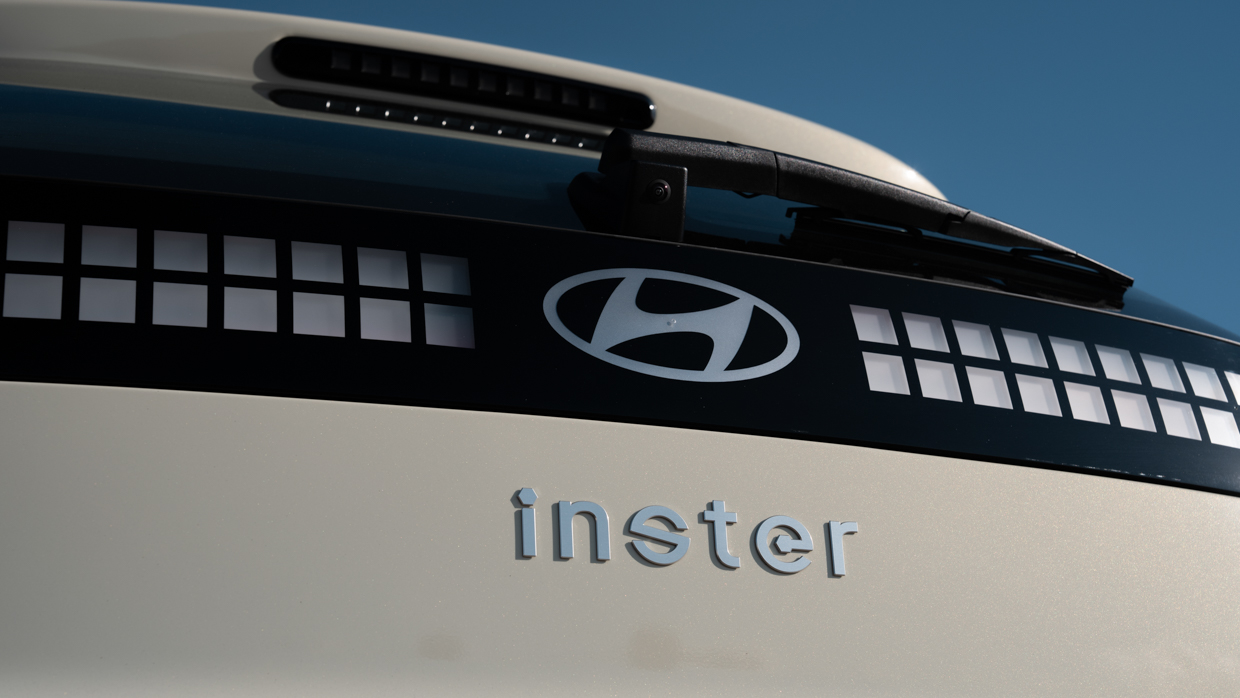
Hyundai also maintains a presence in the petrol-powered light vehicle segment by way of the Venue SUV that is a size larger than Inster, but priced from $25,990 driveaway with manual transmission.
Back in Inster-land, three variants are available to Australians, with relatively beefy standard specification included with the simply-named Inster base grade, which carries the ‘standard range’ 39kWh (usable) battery at $39,000 + ORC:
- 71kW/147Nm front electric motor
- 39.0kWh (usable) nickel manganese cobalt battery
- 15-inch silver alloy wheels with 185/65 R15 Nexen tyres
- Paddle shifters for altering regenerative braking
- Brushed silver roof rails
- Dual projector beam LED headlights
- Parametric pixel LED taillights
- Keyless access to front doors/boot, push-button start
- Obsidian Black recycled PET cloth seat upholstery
- Six-way manually-adjustable driver’s seat
- Leather steering wheel
- 10.25-inch central touchscreen with CCNC operating system
- 10.25-inch digital instrument cluster
- Wireless Apple CarPlay, wireless Android Auto
- Six-speaker stereo
- Four USB ports (2x A, 2x C)
- Wireless device charger
- Bluelink companion smartphone app
- Over-the-air software updates
- Rear parking sensors
- Reversing camera
- Tyre mobility kit (no spare wheel and tyre)

Pictured: Hyundai Inster Standard Range
Spending $3500 more on the Inster Extended Range adds visual appeal, plus around 70km additional range in the real world:
- 84kW/147Nm front electric motor
- 46.0kWh (usable) nickel manganese cobalt battery
- 17-inch black/silver alloy wheels with 205/45 R17 tyres
- No-cost option of Khaki Brown/Newtro Beige recycled PET cloth seat upholstery

Pictured: Hyundai Inster Extended Range
Splash a further $2500 on a near fifty grand (driveaway) rugged-style Inster Cross and you pick up the most premium feature set:
- Black exterior cladding
- Choice of opening glass sunroof or roof box
- Privacy glass
- Obsidian Black or Dark Grey/Amazonas Khaki leather seat upholstery
- Heated and ventilated front seats capable of folding 50:50
- Heated steering wheel
- 64-colour interior ambient lighting
- Front parking sensors
- 360-degree parking camera
- Blind spot view cameras
- Reversing AEB
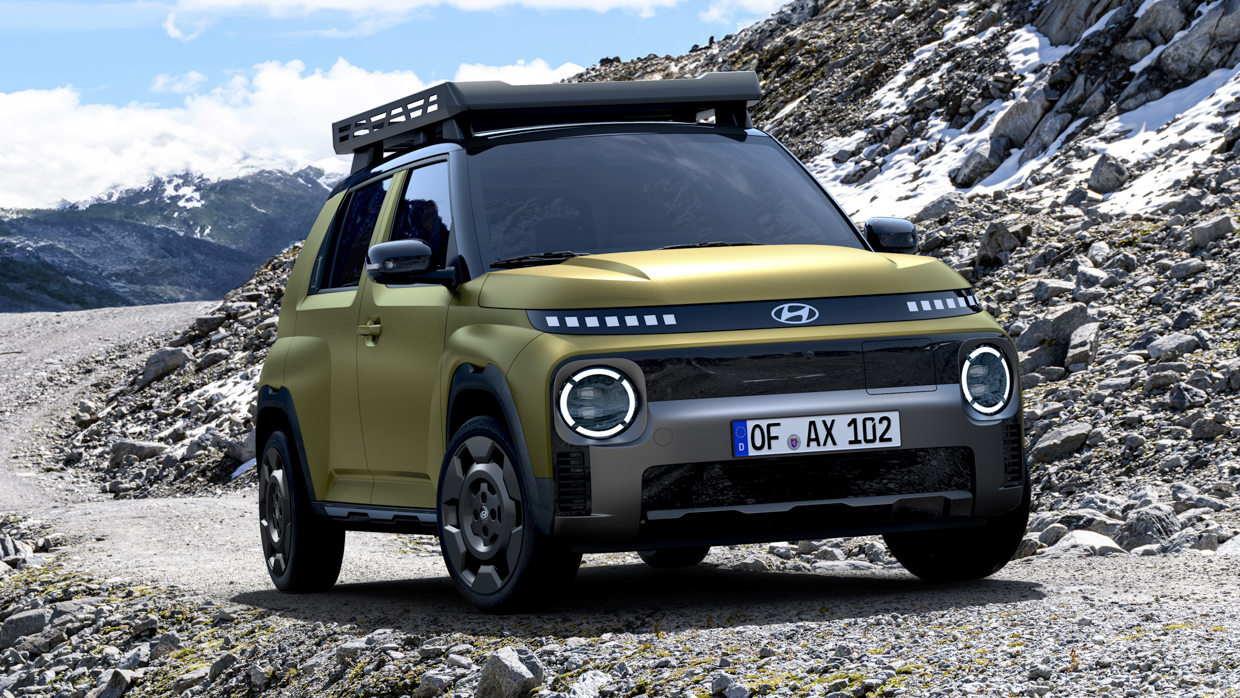
Pictured: Hyundai Inster Cross (roof box optioned)
Our test centred around the base model and the Extended Range. While it makes little financial sense to proceed beyond the $39K entry tier, there’s no doubt that the Extended Range, specified with buttercream interior and 17s, looks fantastic.
How does the Inster drive?
An electric motor is a massive upgrade for ‘cheap’ (in a relative sense), light cars. If the Inster had a petrol engine (as is available in the Korean-market Hyundai Casper), it would be a slow and noisy buzzbox with a dated four-speed automatic transmission.
Electrification turns out to be hugely democratic, bringing untold levels of refinement to a scrappy segment. As you’d expect from really any EV, the Inster accelerates with silken smoothness and near-silence, with no thrashing or gear-changing to get in the way.
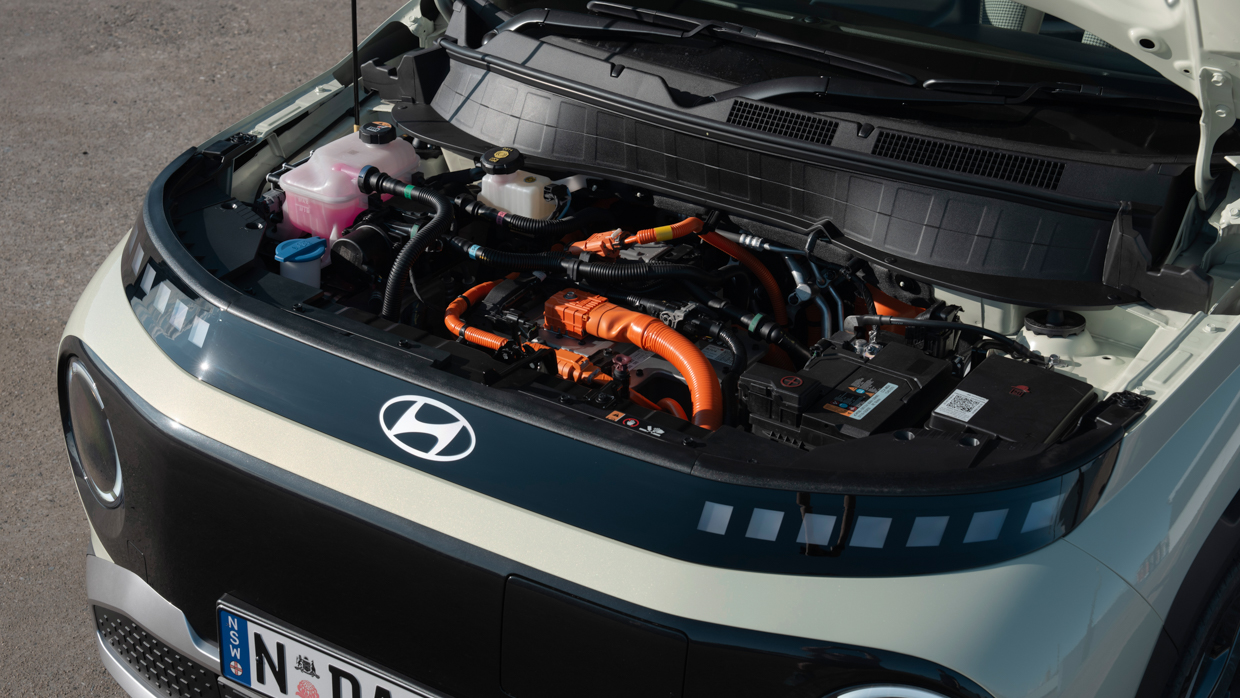
Car fans might shed a tear at the thought, but the fact is most people don’t dream of banging off the rev limiter on their way to work, and the Inster represents a great leap forward from cheap Hyundais of days gone by in this way.
Naturally, you pay for the privilege, with much of the inflated cost of an Inster wrapped up in its 39kWh/46kWh (usable) battery packs that sit beneath the fully-flat floor. The low voltage of the packs (266V/310V) limits power to 71kW/84kW respectively, with torque common at 147Nm for all Insters.
As a result, performance at city speeds is pleasingly rapid – though the car noticeably runs out of puff as you approach triple figures (0-100km/h comes up in 10-11 sec), and overtaking on country roads or the highway requires a bit of planning.

The motor is generally tuned well in both directions, with four-step regenerative braking adjustable through steering wheel paddle shifters all the way to one-pedal drive, though if you prefer to use the brake pedal it has a generally reassuring feel.
Compared to the Inster’s 1060kg petrol-fuelled Casper fraternal twin, the EV is about 300kg heavier – but at circa-1350kg, the Inster is one of the very lightest EVs and in any case, the extra mass sitting atop the 2580mm wheelbase is a blessing in disguise.
That is because the inert battery goes a long way to settling the Inster’s ride and handling, which is inherently limited by the car’s narrow width (1610mm) and diminutive length (3825mm).
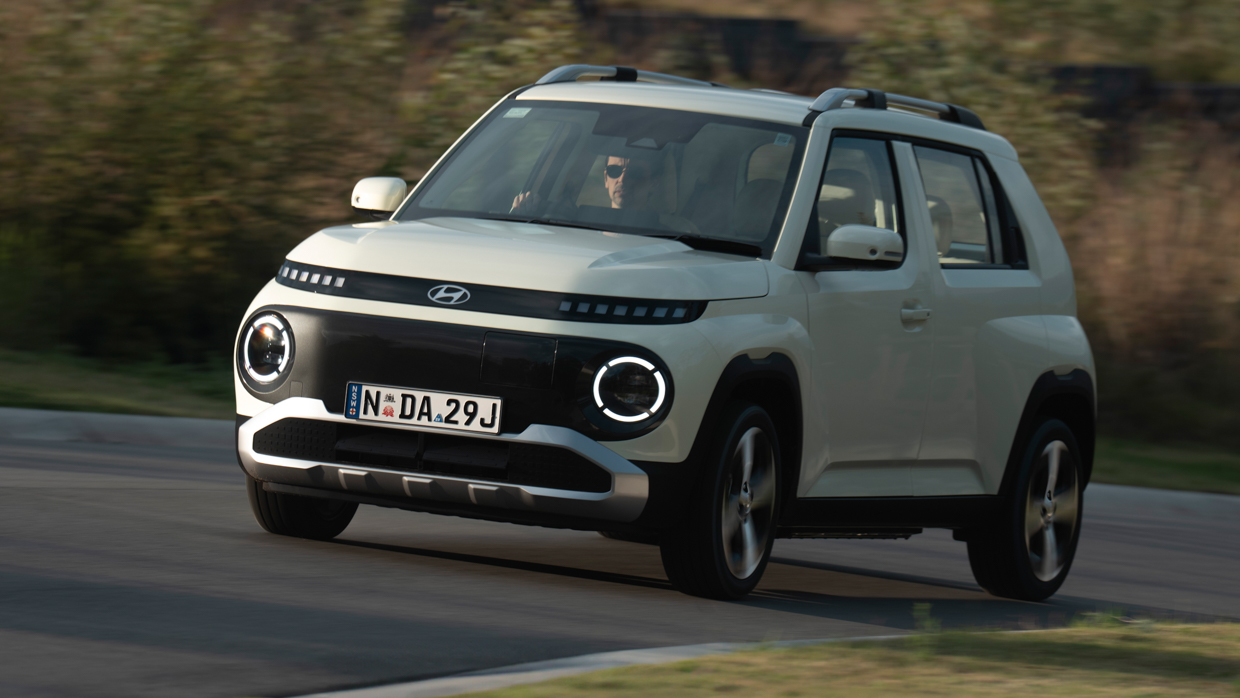
Our launch test loop was very honest, taking in extended bumpy rural segments with alarming potholes…yet the Inster took the imperfections in its stride, never feeling out of its depth until the rain started and the base grade’s 195-width tyres started feeling skittish.
That effect is less pronounced on the Extended Range’s larger wheel/tyre package, which offers more grip, and in the dry, keen drivers can punt the Inster with considerable confidence as the true steering rack and communicative chassis eat up the road.
Even the ride is acceptable, especially on the base 15-inch wheels (with additional cushioning) – while the Extended Range’s 17s are clearly lower-profile and serve up more brittle responses to expansion joints it’s never too bad.
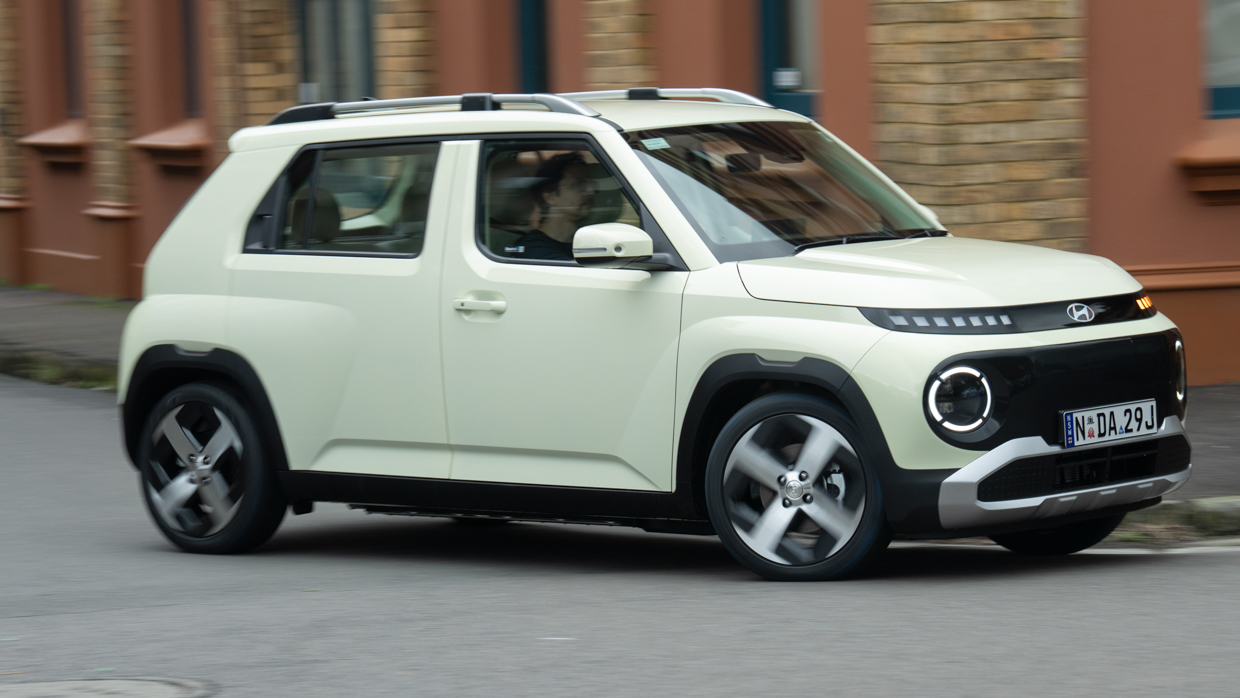
Visibility out of the tall glasshouse is superb, while road noise levels are a touch inflated despite fitment of extended noise insulation material. Something had to give, we suppose.
What is the Inster’s interior and tech like?
Beyond reassuringly adept handling, the other reason you might convince yourself to part with considerable extra cash over a Chinese competitor is the Inster’s beautifully-executed interior.
It’s not especially pretty, or cutting edge, or modern in here. Instead, the Hyundai’s cabin simply works exactly as you’d expect, combining the right level of technology with the right level of physical switchgear for climate, media and driving controls.
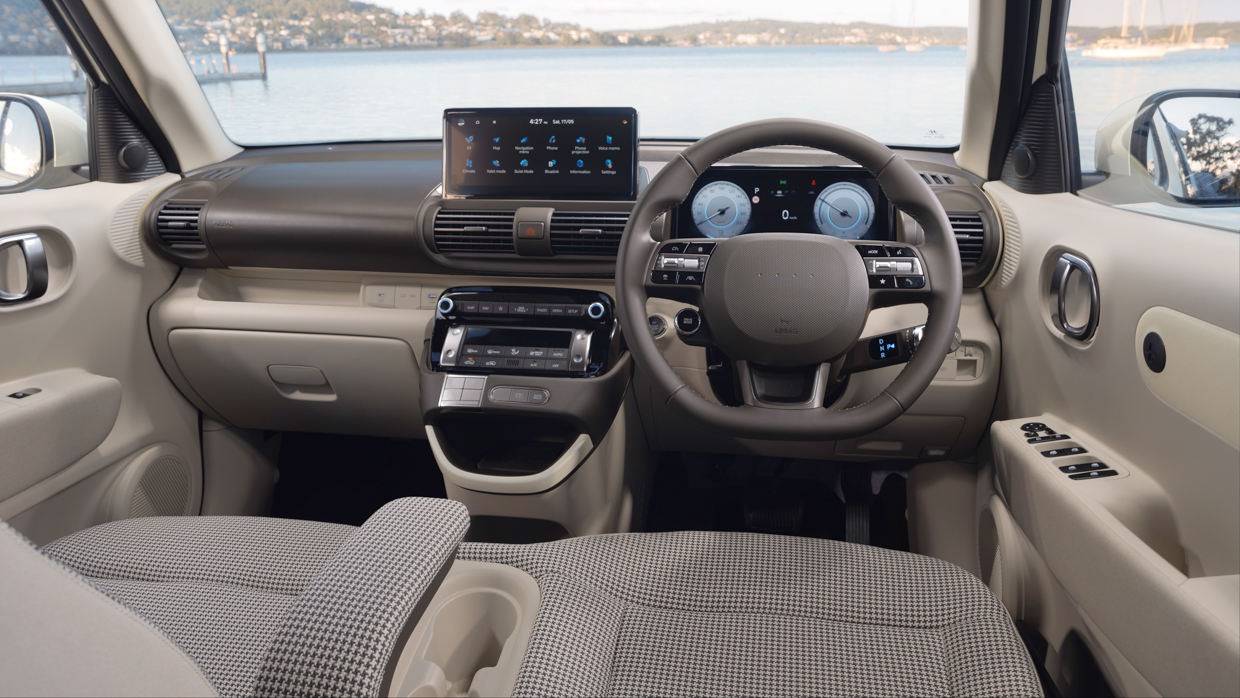
Once your phone is connected to standard CarPlay/Android Auto, presented on the leftmost of two clear 10.0-inch screens, there is next to no learning curve here as the Inster makes life so easy, with key controls falling right to hand. It’s the antithesis of confronting or odd.
Want to adjust the fan while driving? There’s a rocker for that. Volume? The dial doesn’t move places. Schedule overnight charging? Easy with Hyundai’s slick software, while impressively, all Insters get five years of complimentary vehicle networking with locking, charging and climate functions remotely controllable from your phone.
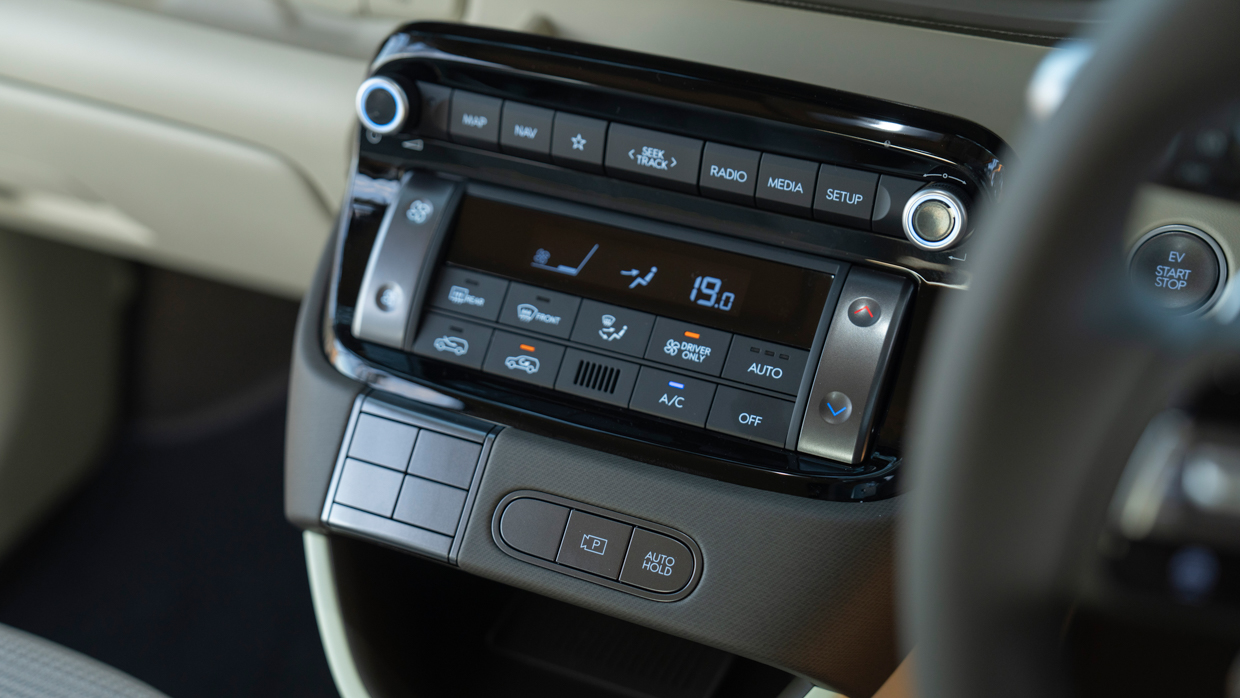
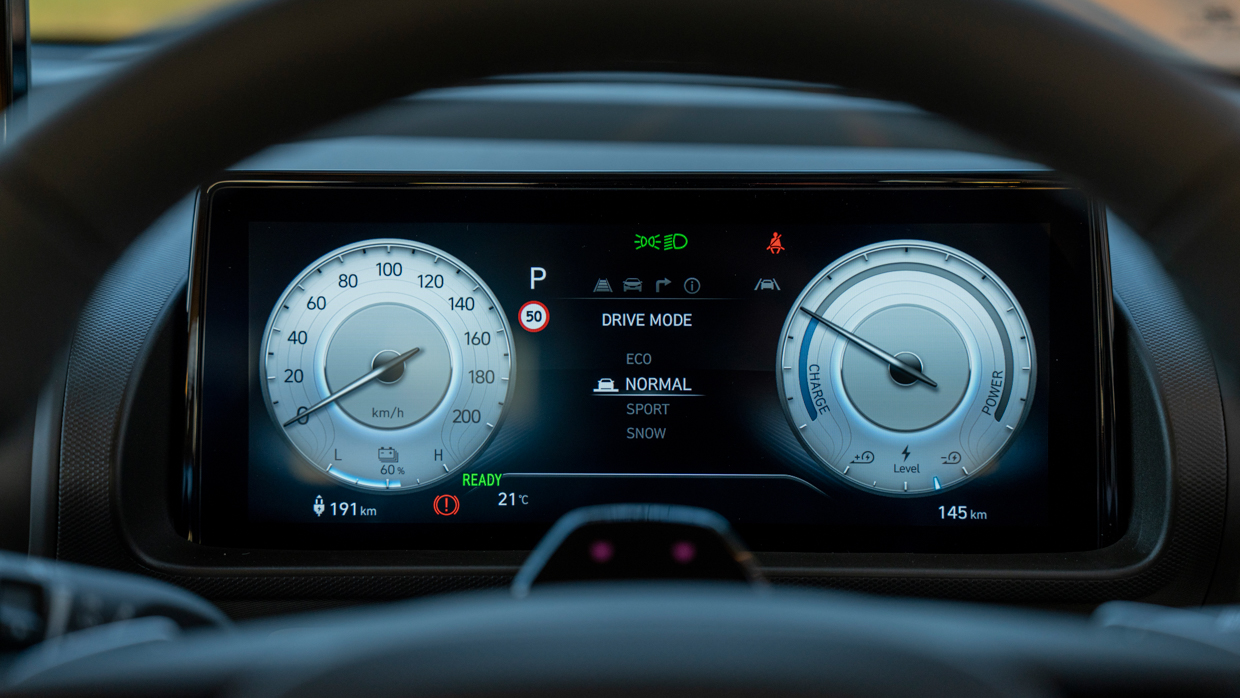
Once you’re done marvelling at how a new car in 2025 (and an electric one at that) doesn’t have to resemble a touchscreen-driven spaceship inside, a few shortcomings start to become clear.
A big one is that, while Hyundai Australia has lavished quite decent specification on the Inster for local consumption, it doesn’t feel plush or posh in here as petrol cars of the same price do – we’re in Volkswagen Golf territory here, which isn’t an EV (yet) but features much nicer plastics and surfacing.
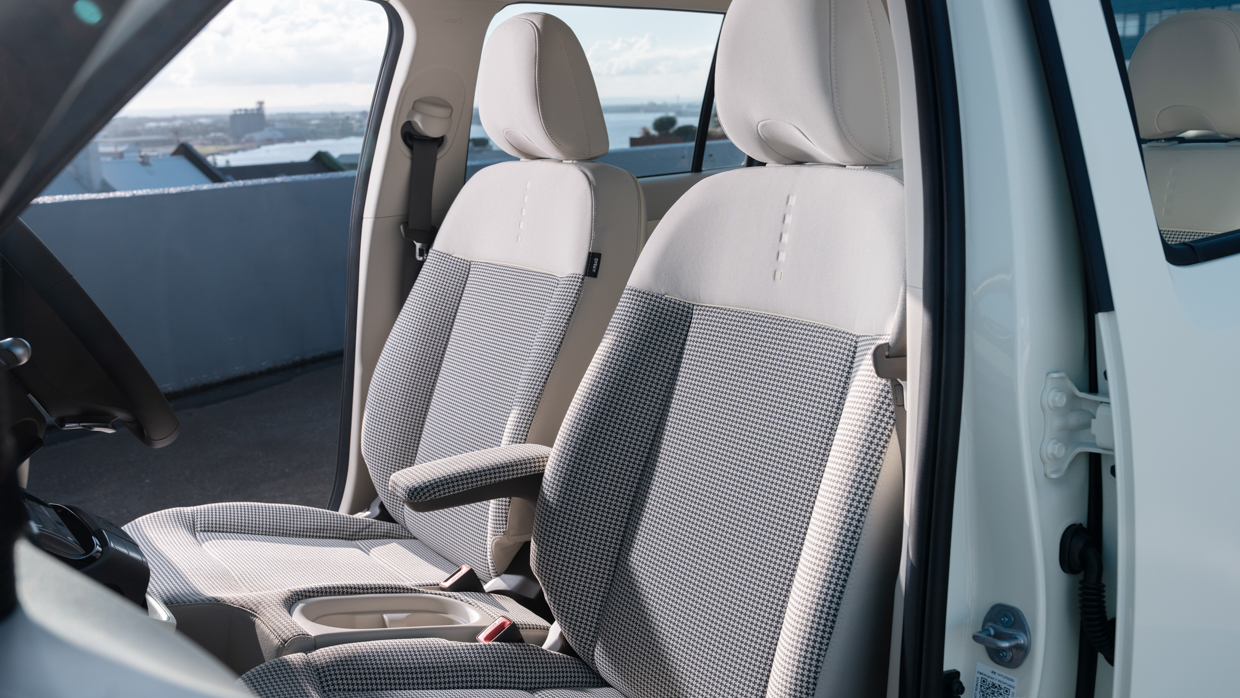
Same with the seats: the front bench seat (with flip-down armrest) is absolutely fine for short trips or even a couple of hours in the car, but the lack of lumbar and only simple manual adjustments mean finding a great driving position is tough.
The narrowness of the Inster confines it to four seats only, and robs the doors of storage room – but at least there are plentiful opportunities to stash clutter in open boxes throughout the dash stack.
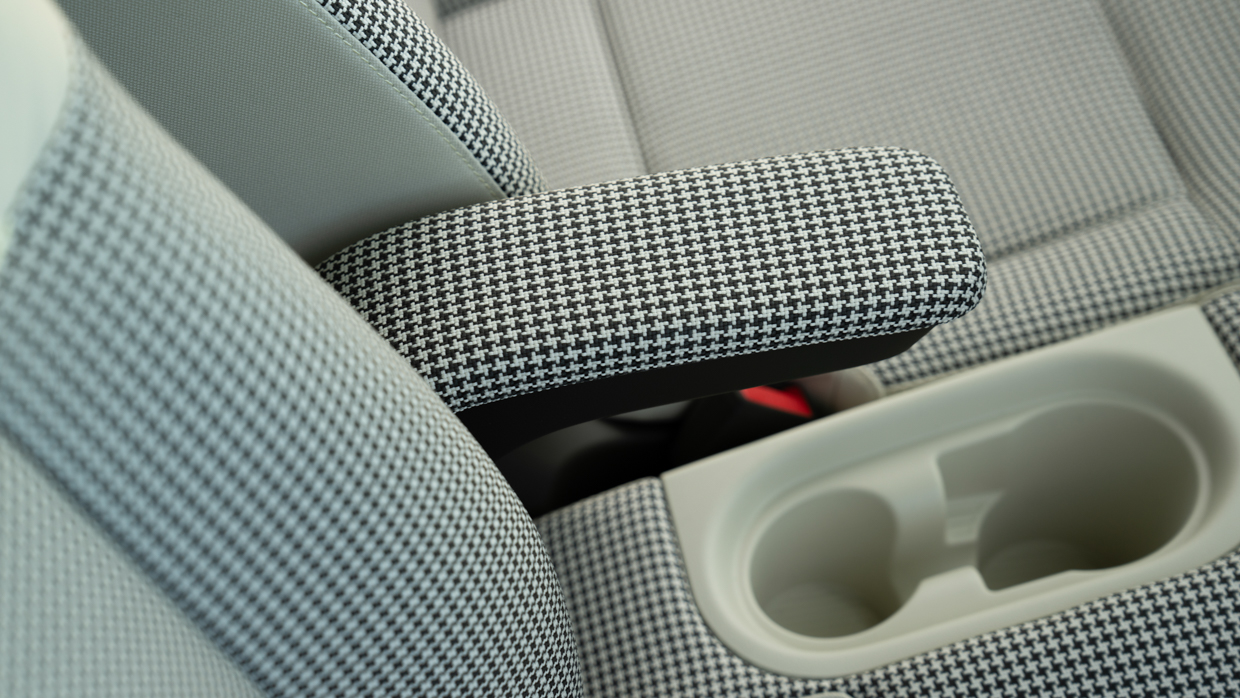
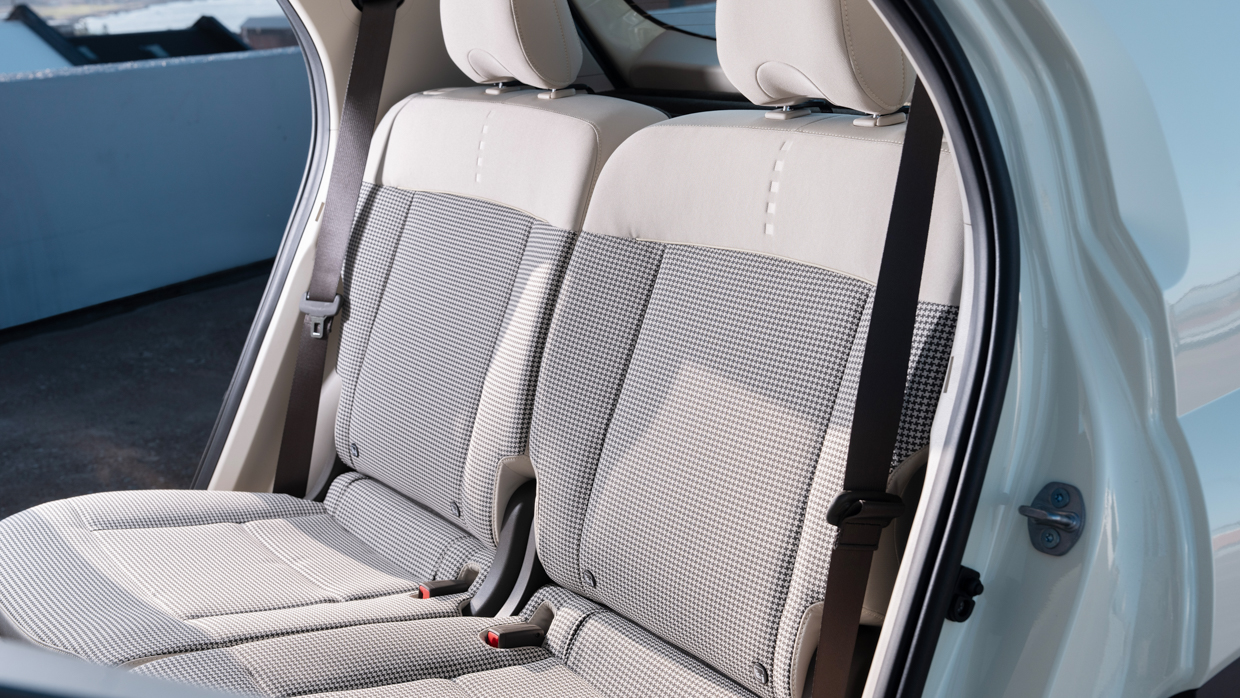
Row two is amazingly accommodating if the seats are slid/relined into their rearmost position, easily swallowing adults – or you can bring the seats forward to maximse the boot (to 351L). No air vents or armrest, though, so back passengers are certainly second-class.
The back seats fold flat (50/50), while opting for the Inster Cross also allows the front pews to fold flat too – and an accessory mattress can be placed allowing two to camp in-car.

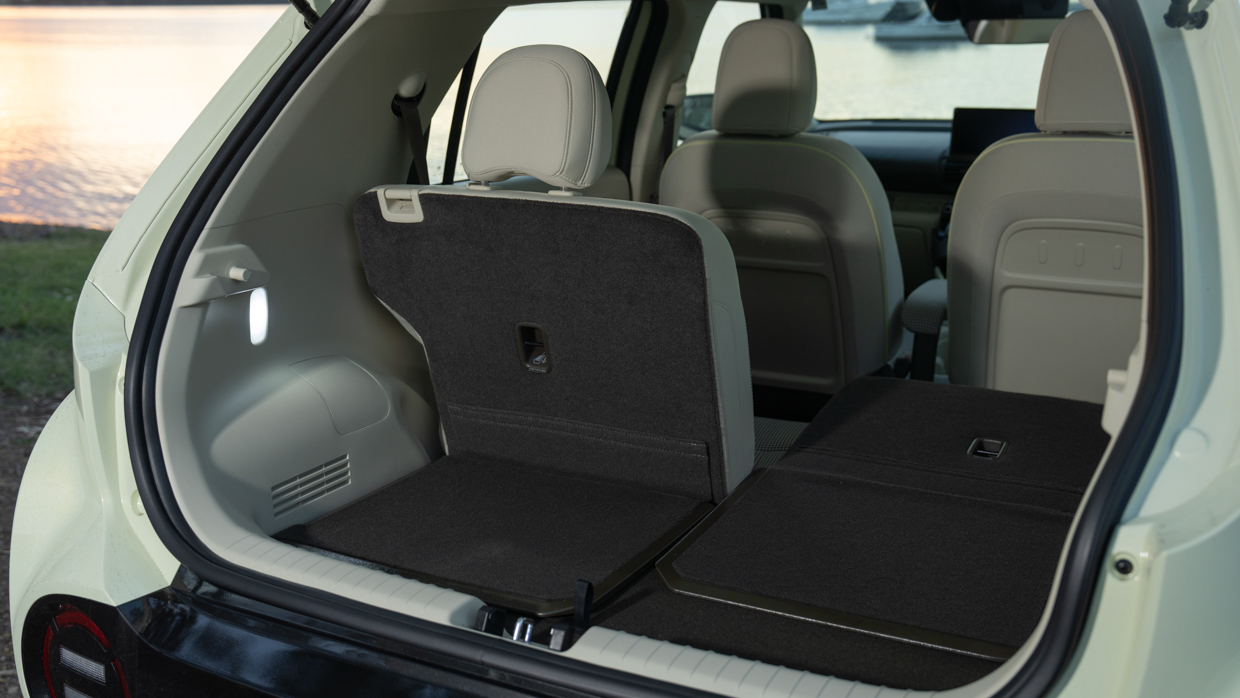
Is the Inster a safe car?
Neither Euro NCAP nor ANCAP have rated the Inster’s safety credentials as yet and Hyundai executives won’t be drawn on whether it will receive five stars – but the manufacturer says it is happy to give ANCAP a car if they want to test an Inster.
What is known is that the level of safety tech in the Inster is fairly extensive, and most of the systems we tested worked well.
Forwards and junction AEB is standard across the range, though only the Cross scores reversing AEB – a black mark – while Cross exclusives also extend to a 360-degree parking camera and Hyundai’s excellent blind spot view cameras.
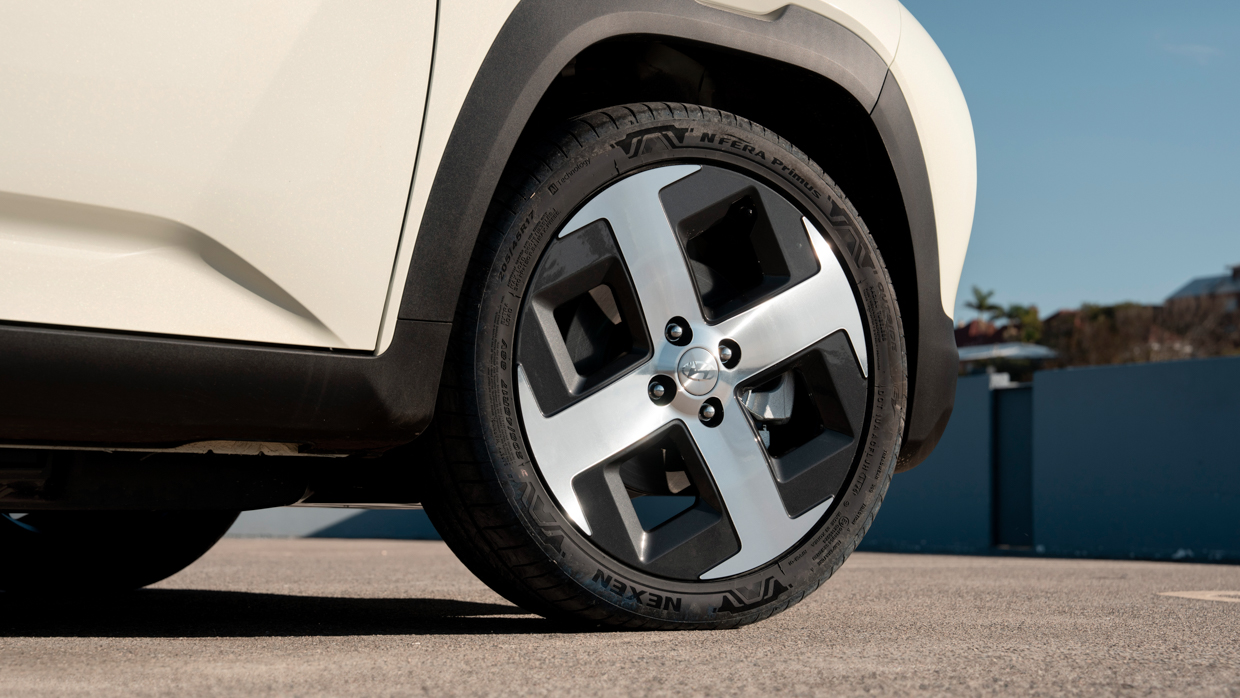
Otherwise, all specs enjoy strong adaptive cruise control and lane-centring, which works well. Hyundai’s overzealous speed limit monitoring is still there, but can now be silenced with a long press of the ‘mute’ button on the steering wheel.
Overzealous is also the word for the constant driver monitoring, and this is harder to deactivate each drive.
What are the Inster’s ownership costs?
Low running costs are the order of the day for the Inster because it is very efficient – equalling the Tesla Model Y as the most miserly EV we have tested (though the Tesla is admittedly even more impressive as it’s so much larger).
We easily managed 11.0kWh/100km consumption from the Extended Range in town, while sportier country driving saw the figure escalate to 12kWh/100km; the highway sees use of a more mediocre 15.5kWh/100km.
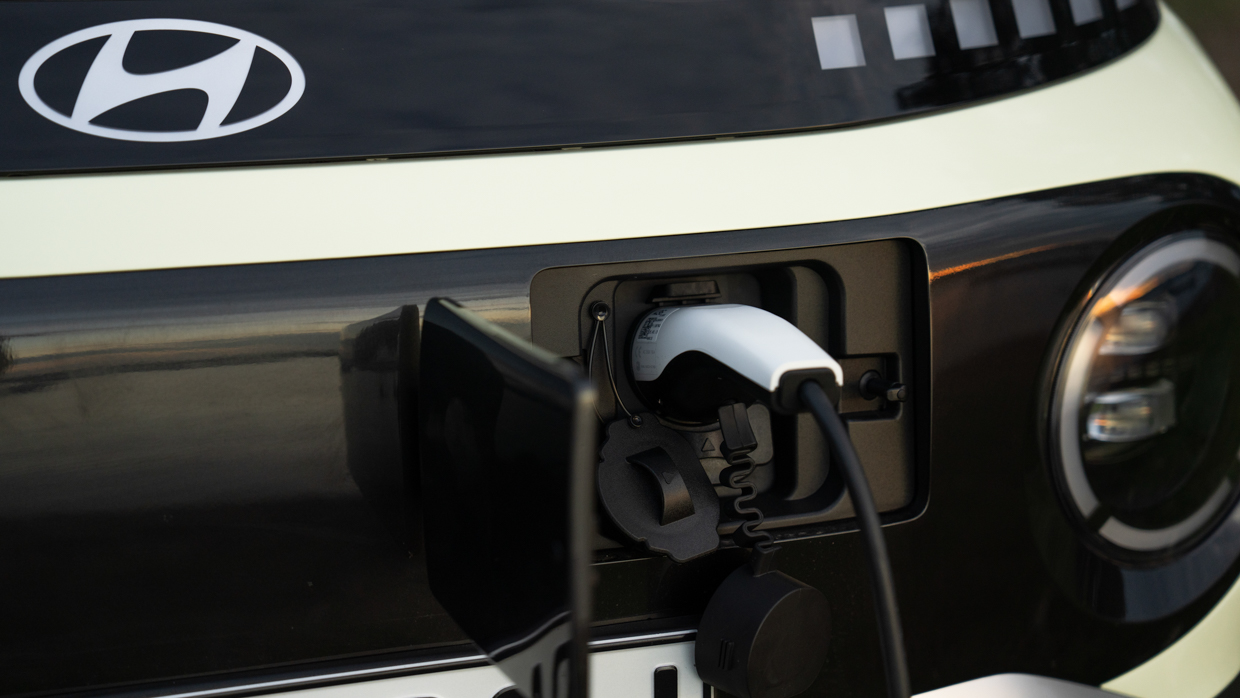
Efficiency did not differ much between the battery sizes, meaning real-world range to exhaustion of between 296km-418km for the Extended Range and 232km-327km for the base car. We haven’t tested the Cross properly yet, but its optional roof box is understood to cut range by 30 percent or so.
DC charging speeds peak at a decent 120kW, while a 10-80% session averages 64kW and takes 30 minutes. AC charging can be done at up to 11kW; a simple GPO socket will replenish half the battery overnight.
Warranty is five years with unlimited kilometres, though Chasing Cars understands that Hyundai is on the cusp of announcing a move to a seven-year warranty which will be backdated to all cars the brand has sold in 2025.
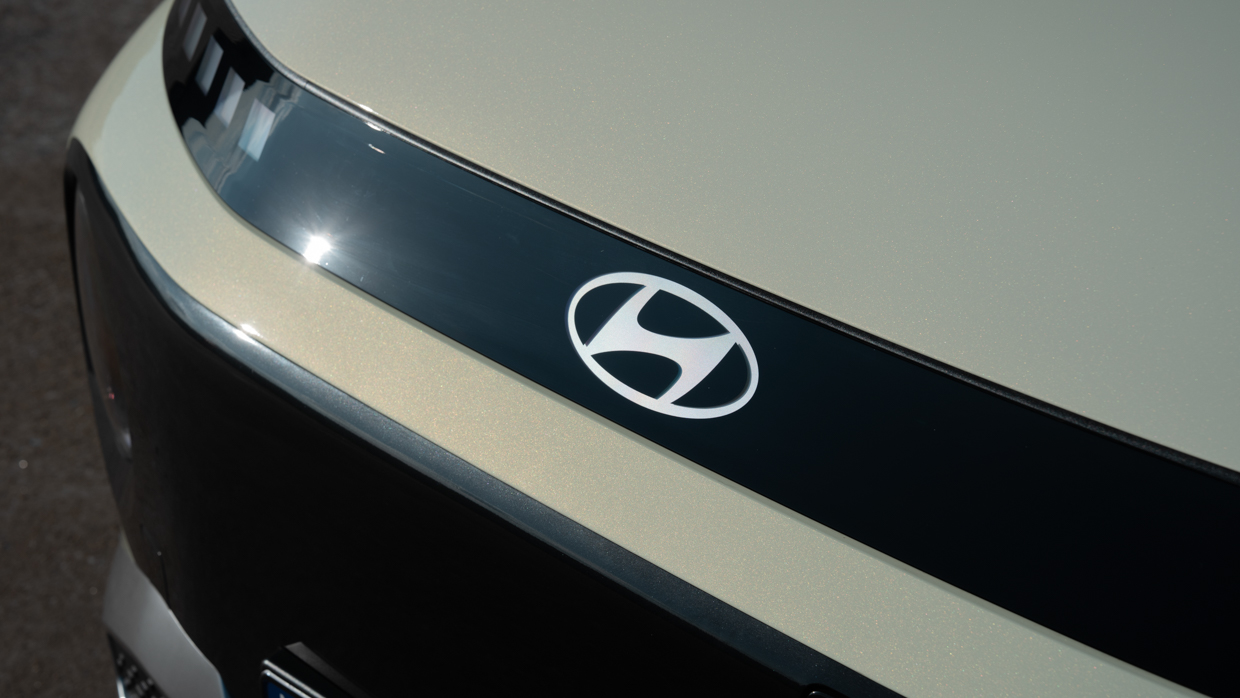
Service intervals for Inster are every two years/30,000km, with the first two services confirmed to cost $655 apiece.
The honest verdict on the Inster
If you’re motivated by price alone in the ‘cheap and cheerful’ small EV segment, then the Inster isn’t likely to catch your fancy unless Hyundai starts indulging in discounting. For now, brand execs are adamant they don’t want to do so.
However, if you can look beyond the premium sticker price, the Hyundai Inster is seriously impressive. Here’s a fully-electric car that delivers incredible efficiency, light weight, a straightforward and ergonomic interior, and dynamics far more polished than you would expect.

Hyundai bosses declare that the maturity embodied in those achievements costs money, and that Australians who ‘get it’ will be willing to spend a bit more on an Inster than they would on a less dependable, lesser known car from rival brands.
We agree that the Inster justifiably costs a bit more than a BYD Dolphin, for instance. But $9000 more might be a little too steep. At the time of writing, the right price for the Inster is closer to the mid-thirties than the low-forties driveaway.
Still, if you’re buying an Inster to keep for some time (perhaps as a car for your kids to share, or to have as a second vehicle in the garage), it could well make sense to splash a bit more on quality – because frankly, that’s what Hyundai appears to have delivered.



